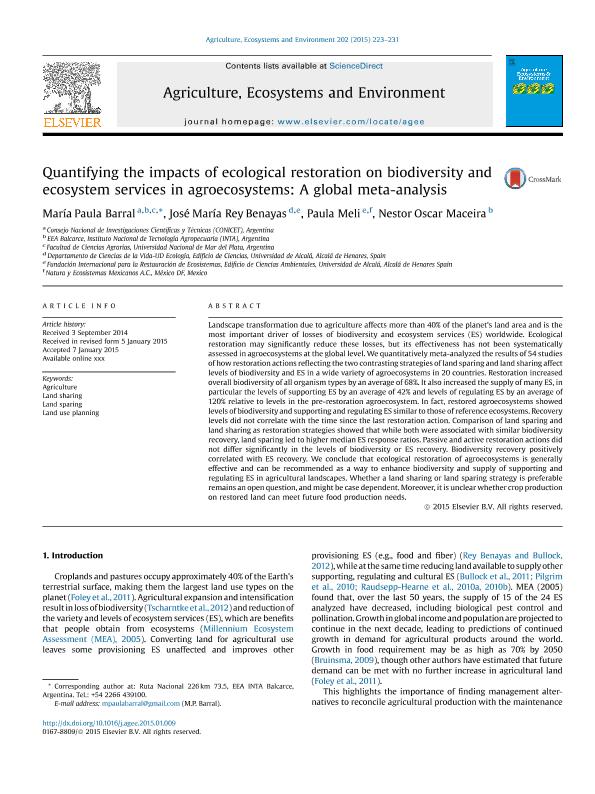Mostrar el registro sencillo del ítem
dc.contributor.author
Barral, María Paula

dc.contributor.author
Rey Benayas, José María
dc.contributor.author
Meli, Paula
dc.contributor.author
Maceira, Nestor Oscar

dc.date.available
2018-05-16T17:40:30Z
dc.date.issued
2015-03
dc.identifier.citation
Barral, María Paula; Rey Benayas, José María; Meli, Paula; Maceira, Nestor Oscar; Quantifying the impacts of ecological restoration on biodiversity and ecosystem services in agroecosystems: A global meta-analysis; Elsevier Science; Agriculture, Ecosystems and Environment; 202; 3-2015; 223-231
dc.identifier.issn
0167-8809
dc.identifier.uri
http://hdl.handle.net/11336/45390
dc.description.abstract
Landscape transformation due to agriculture affects more than 40% of the planet´s land area and is the most important driver of losses of biodiversity and ecosystem services (ES) worldwide. Ecological restoration may significantly reduce these losses, but its effectiveness has not been systematically assessed in agroecosystems at the global level. We quantitatively meta-analyzed the results of 54 studies of how restoration actions reflecting the two contrasting strategies of land sparing and land sharing affect levels of biodiversity and ES in a wide variety of agroecosystems in 20 countries. Restoration increased overall biodiversity of all organism types by an average of 68%. It also increased the supply of many ES, in particular the levels of supporting ES by an average of 42% and levels of regulating ES by an average of 120% relative to levels in the pre-restoration agroecosystem. In fact, restored agroecosystems showed levels of biodiversity and supporting and regulating ES similar to those of reference ecosystems. Recovery levels did not correlate with the time since the last restoration action. Comparison of land sparing and land sharing as restoration strategies showed that while both were associated with similar biodiversity recovery, land sparing led to higher median ES response ratios. Passive and active restoration actions did not differ significantly in the levels of biodiversity or ES recovery. Biodiversity recovery positively correlated with ES recovery. We conclude that ecological restoration of agroecosystems is generally effective and can be recommended as a way to enhance biodiversity and supply of supporting and regulating ES in agricultural landscapes. Whether a land sharing or land sparing strategy is preferable remains an open question, and might be case dependent. Moreover, it is unclear whether crop production on restored land can meet future food production needs.
dc.format
application/pdf
dc.language.iso
eng
dc.publisher
Elsevier Science

dc.rights
info:eu-repo/semantics/openAccess
dc.rights.uri
https://creativecommons.org/licenses/by-nc-sa/2.5/ar/
dc.subject
Agriculture
dc.subject
Land Sharing
dc.subject
Land Sparing
dc.subject
Land Use Planning
dc.subject.classification
Otras Ciencias Biológicas

dc.subject.classification
Ciencias Biológicas

dc.subject.classification
CIENCIAS NATURALES Y EXACTAS

dc.title
Quantifying the impacts of ecological restoration on biodiversity and ecosystem services in agroecosystems: A global meta-analysis
dc.type
info:eu-repo/semantics/article
dc.type
info:ar-repo/semantics/artículo
dc.type
info:eu-repo/semantics/publishedVersion
dc.date.updated
2018-05-03T16:39:55Z
dc.journal.volume
202
dc.journal.pagination
223-231
dc.journal.pais
Países Bajos

dc.journal.ciudad
Amsterdam
dc.description.fil
Fil: Barral, María Paula. Consejo Nacional de Investigaciones Científicas y Técnicas; Argentina. Instituto Nacional de Tecnología Agropecuaria. Centro Regional Buenos Aires Sur. Estación Experimental Agropecuaria Balcarce; Argentina. Universidad Nacional de Mar del Plata; Argentina
dc.description.fil
Fil: Rey Benayas, José María. Universidad de Alcalá; España
dc.description.fil
Fil: Meli, Paula. Universidad de Alcalá; España
dc.description.fil
Fil: Maceira, Nestor Oscar. Instituto Nacional de Tecnología Agropecuaria. Centro Regional Buenos Aires Sur. Estación Experimental Agropecuaria Balcarce. Area de Invest.en Agronomia; Argentina. Consejo Nacional de Investigaciones Científicas y Técnicas; Argentina
dc.journal.title
Agriculture, Ecosystems and Environment

dc.relation.alternativeid
info:eu-repo/semantics/altIdentifier/url/https://www.sciencedirect.com/science/article/pii/S0167880915000109
dc.relation.alternativeid
info:eu-repo/semantics/altIdentifier/doi/http://dx.doi.org/10.1016/j.agee.2015.01.009
Archivos asociados
